Porter's Diamond Model Analysis: Mobile Infrastructure in Myanmar
VerifiedAdded on 2020/05/28
|5
|790
|138
Report
AI Summary
This report provides an analysis of Myanmar's mobile infrastructure using Porter's Diamond Model. It examines the demand conditions, highlighting the industry's growth stage and fluctuating customer preferences due to rapid technological advancements. The report discusses the market size, the presence of key players like Telenor, Ooredoo, and the dominance of Chinese brands. It also analyzes the 'chance' factors, including the number of operators and infrastructure developments like mobile tower construction. The report briefly touches on the government's role, including funding and policy impacts on network expansion. Overall, the analysis suggests a high demand and good investment opportunities within the Myanmar mobile industry.
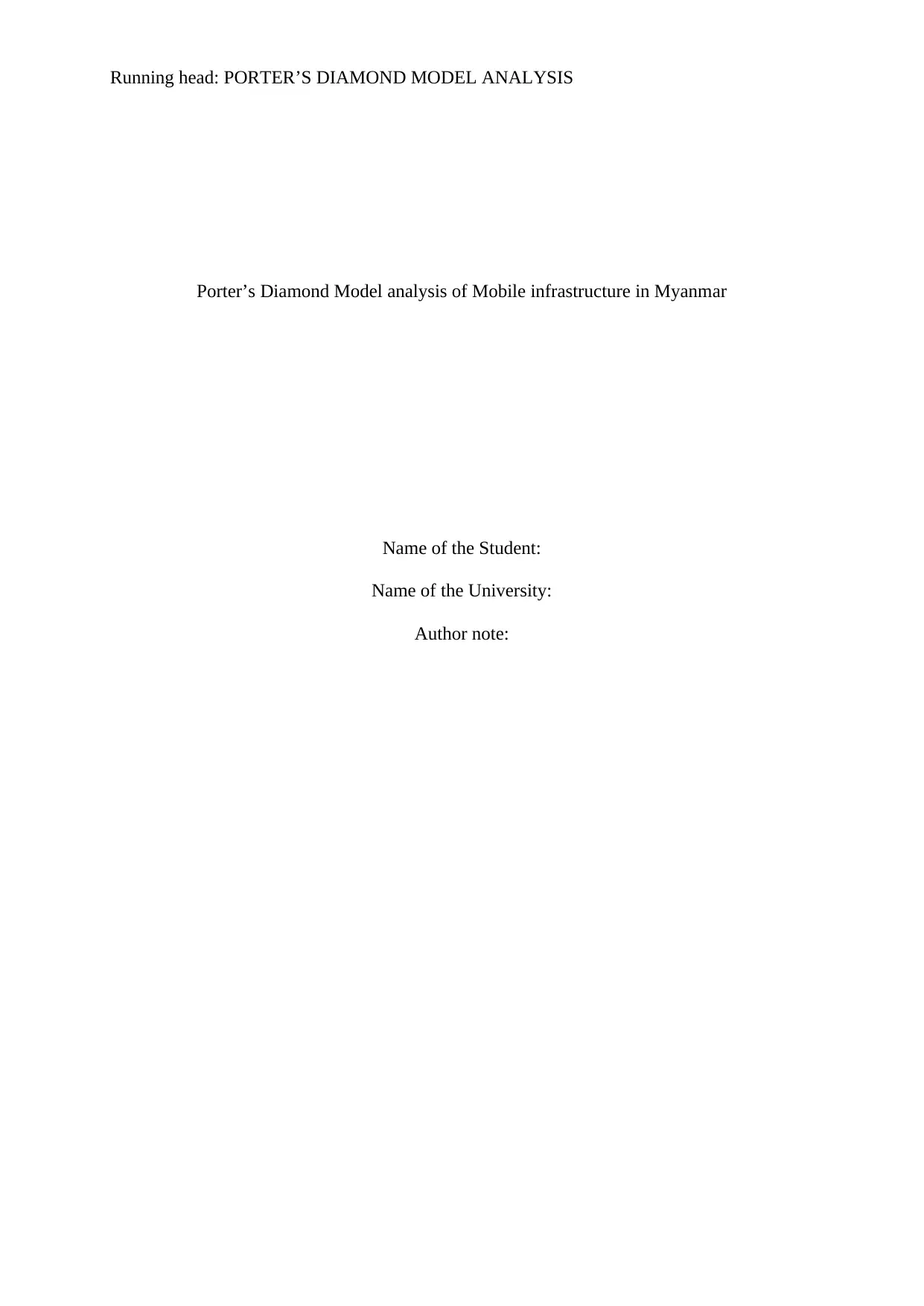
Running head: PORTER’S DIAMOND MODEL ANALYSIS
Porter’s Diamond Model analysis of Mobile infrastructure in Myanmar
Name of the Student:
Name of the University:
Author note:
Porter’s Diamond Model analysis of Mobile infrastructure in Myanmar
Name of the Student:
Name of the University:
Author note:
Paraphrase This Document
Need a fresh take? Get an instant paraphrase of this document with our AI Paraphraser
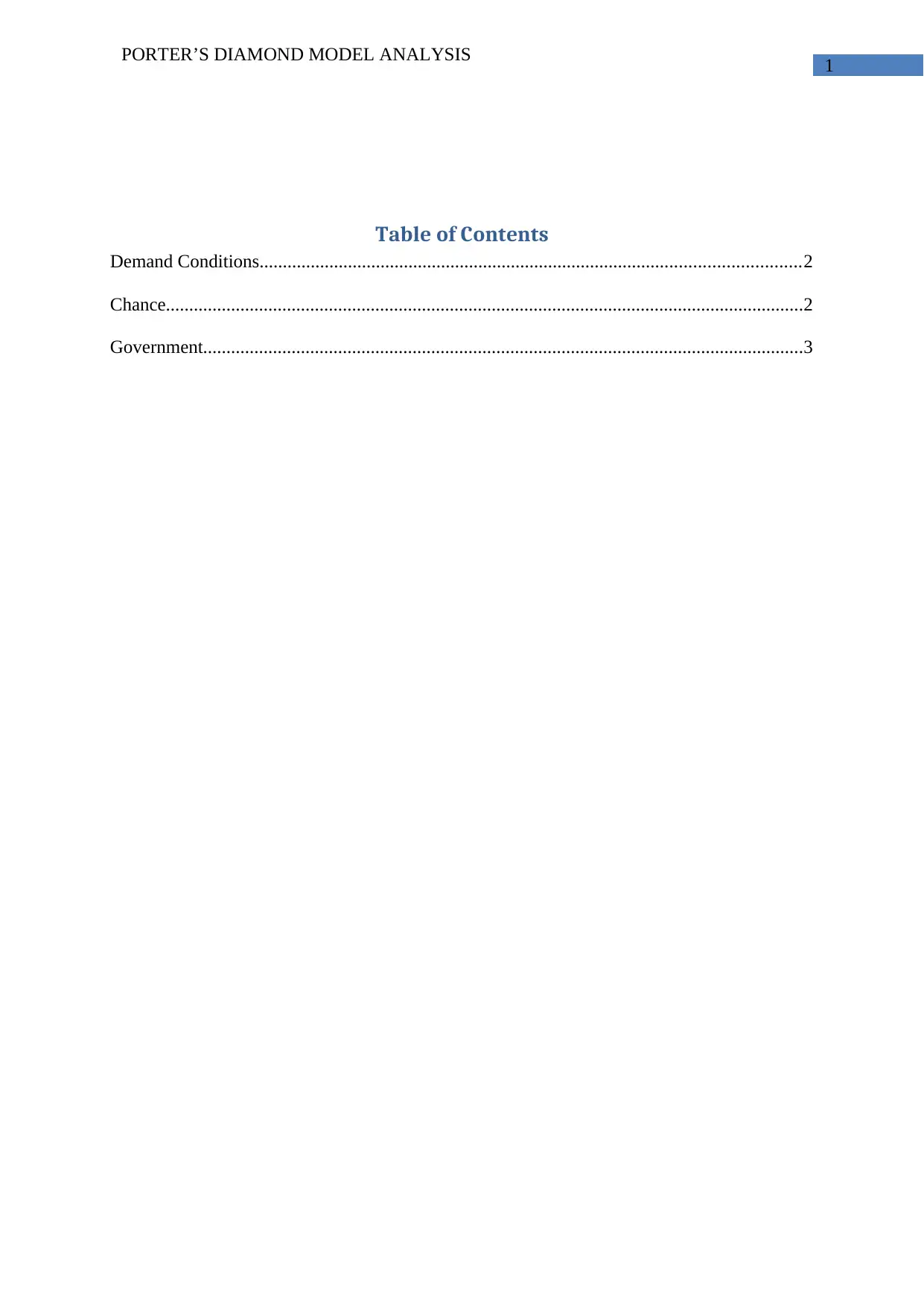
1
PORTER’S DIAMOND MODEL ANALYSIS
Table of Contents
Demand Conditions....................................................................................................................2
Chance.........................................................................................................................................2
Government.................................................................................................................................3
PORTER’S DIAMOND MODEL ANALYSIS
Table of Contents
Demand Conditions....................................................................................................................2
Chance.........................................................................................................................................2
Government.................................................................................................................................3
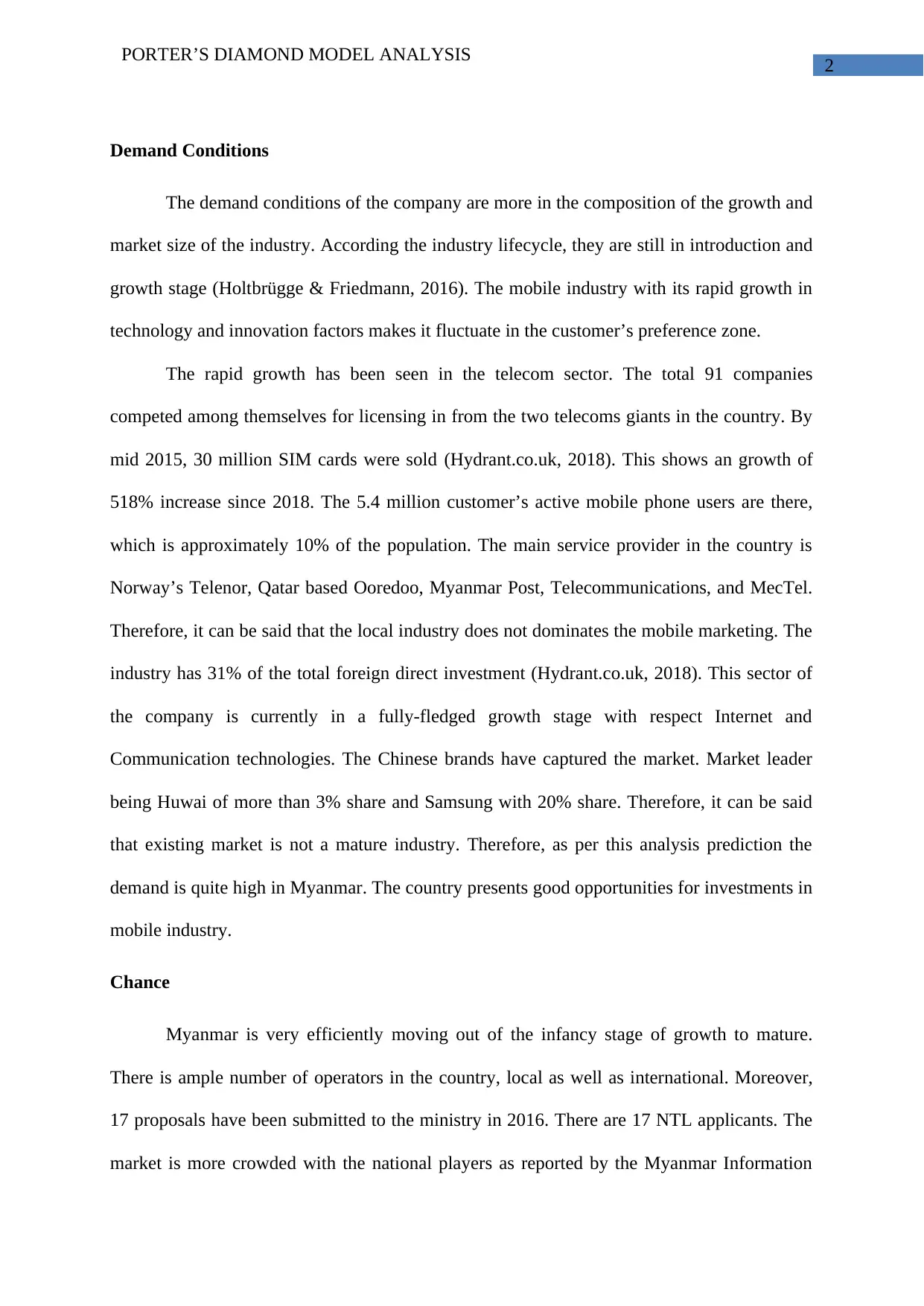
2
PORTER’S DIAMOND MODEL ANALYSIS
Demand Conditions
The demand conditions of the company are more in the composition of the growth and
market size of the industry. According the industry lifecycle, they are still in introduction and
growth stage (Holtbrügge & Friedmann, 2016). The mobile industry with its rapid growth in
technology and innovation factors makes it fluctuate in the customer’s preference zone.
The rapid growth has been seen in the telecom sector. The total 91 companies
competed among themselves for licensing in from the two telecoms giants in the country. By
mid 2015, 30 million SIM cards were sold (Hydrant.co.uk, 2018). This shows an growth of
518% increase since 2018. The 5.4 million customer’s active mobile phone users are there,
which is approximately 10% of the population. The main service provider in the country is
Norway’s Telenor, Qatar based Ooredoo, Myanmar Post, Telecommunications, and MecTel.
Therefore, it can be said that the local industry does not dominates the mobile marketing. The
industry has 31% of the total foreign direct investment (Hydrant.co.uk, 2018). This sector of
the company is currently in a fully-fledged growth stage with respect Internet and
Communication technologies. The Chinese brands have captured the market. Market leader
being Huwai of more than 3% share and Samsung with 20% share. Therefore, it can be said
that existing market is not a mature industry. Therefore, as per this analysis prediction the
demand is quite high in Myanmar. The country presents good opportunities for investments in
mobile industry.
Chance
Myanmar is very efficiently moving out of the infancy stage of growth to mature.
There is ample number of operators in the country, local as well as international. Moreover,
17 proposals have been submitted to the ministry in 2016. There are 17 NTL applicants. The
market is more crowded with the national players as reported by the Myanmar Information
PORTER’S DIAMOND MODEL ANALYSIS
Demand Conditions
The demand conditions of the company are more in the composition of the growth and
market size of the industry. According the industry lifecycle, they are still in introduction and
growth stage (Holtbrügge & Friedmann, 2016). The mobile industry with its rapid growth in
technology and innovation factors makes it fluctuate in the customer’s preference zone.
The rapid growth has been seen in the telecom sector. The total 91 companies
competed among themselves for licensing in from the two telecoms giants in the country. By
mid 2015, 30 million SIM cards were sold (Hydrant.co.uk, 2018). This shows an growth of
518% increase since 2018. The 5.4 million customer’s active mobile phone users are there,
which is approximately 10% of the population. The main service provider in the country is
Norway’s Telenor, Qatar based Ooredoo, Myanmar Post, Telecommunications, and MecTel.
Therefore, it can be said that the local industry does not dominates the mobile marketing. The
industry has 31% of the total foreign direct investment (Hydrant.co.uk, 2018). This sector of
the company is currently in a fully-fledged growth stage with respect Internet and
Communication technologies. The Chinese brands have captured the market. Market leader
being Huwai of more than 3% share and Samsung with 20% share. Therefore, it can be said
that existing market is not a mature industry. Therefore, as per this analysis prediction the
demand is quite high in Myanmar. The country presents good opportunities for investments in
mobile industry.
Chance
Myanmar is very efficiently moving out of the infancy stage of growth to mature.
There is ample number of operators in the country, local as well as international. Moreover,
17 proposals have been submitted to the ministry in 2016. There are 17 NTL applicants. The
market is more crowded with the national players as reported by the Myanmar Information
⊘ This is a preview!⊘
Do you want full access?
Subscribe today to unlock all pages.

Trusted by 1+ million students worldwide
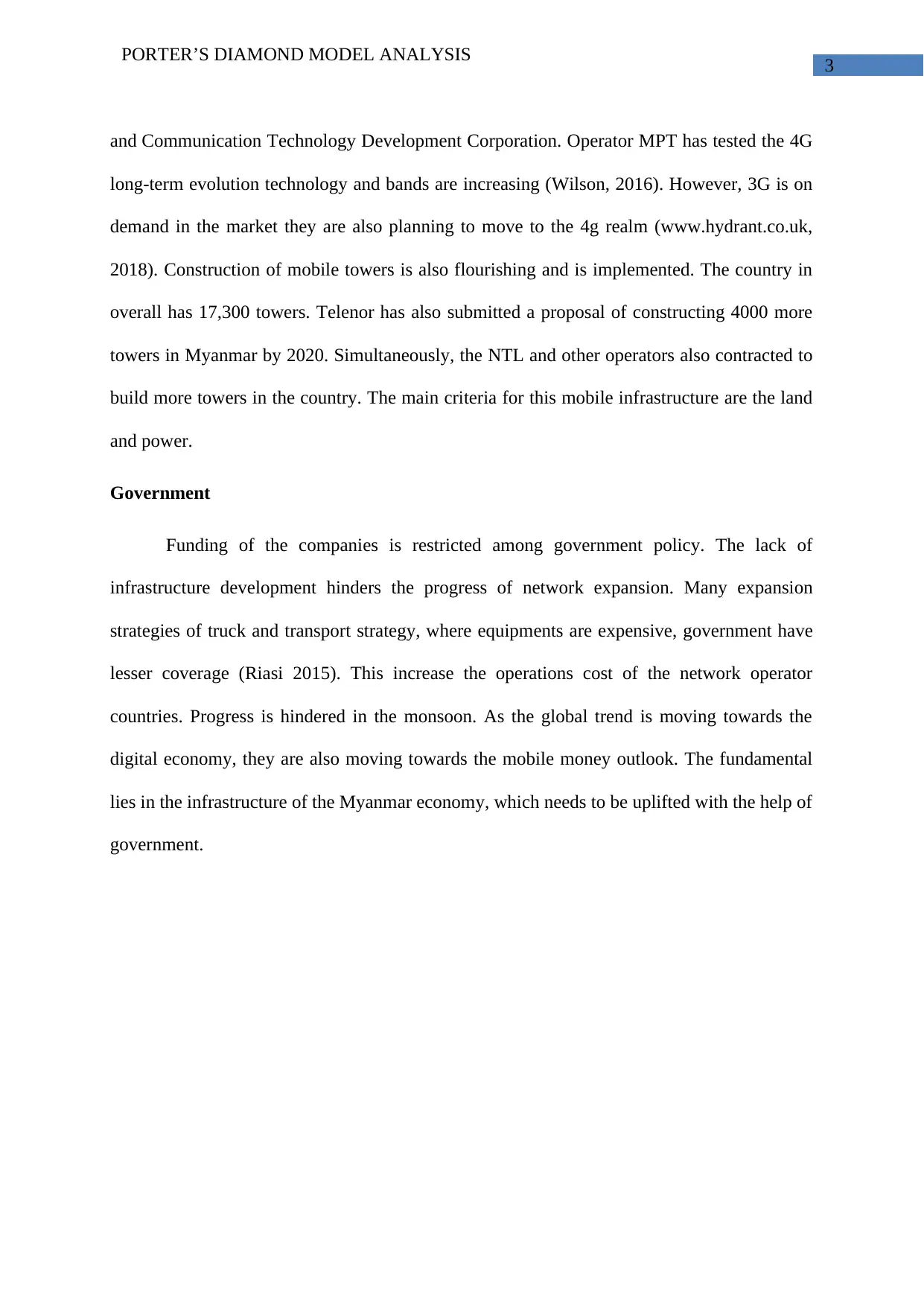
3
PORTER’S DIAMOND MODEL ANALYSIS
and Communication Technology Development Corporation. Operator MPT has tested the 4G
long-term evolution technology and bands are increasing (Wilson, 2016). However, 3G is on
demand in the market they are also planning to move to the 4g realm (www.hydrant.co.uk,
2018). Construction of mobile towers is also flourishing and is implemented. The country in
overall has 17,300 towers. Telenor has also submitted a proposal of constructing 4000 more
towers in Myanmar by 2020. Simultaneously, the NTL and other operators also contracted to
build more towers in the country. The main criteria for this mobile infrastructure are the land
and power.
Government
Funding of the companies is restricted among government policy. The lack of
infrastructure development hinders the progress of network expansion. Many expansion
strategies of truck and transport strategy, where equipments are expensive, government have
lesser coverage (Riasi 2015). This increase the operations cost of the network operator
countries. Progress is hindered in the monsoon. As the global trend is moving towards the
digital economy, they are also moving towards the mobile money outlook. The fundamental
lies in the infrastructure of the Myanmar economy, which needs to be uplifted with the help of
government.
PORTER’S DIAMOND MODEL ANALYSIS
and Communication Technology Development Corporation. Operator MPT has tested the 4G
long-term evolution technology and bands are increasing (Wilson, 2016). However, 3G is on
demand in the market they are also planning to move to the 4g realm (www.hydrant.co.uk,
2018). Construction of mobile towers is also flourishing and is implemented. The country in
overall has 17,300 towers. Telenor has also submitted a proposal of constructing 4000 more
towers in Myanmar by 2020. Simultaneously, the NTL and other operators also contracted to
build more towers in the country. The main criteria for this mobile infrastructure are the land
and power.
Government
Funding of the companies is restricted among government policy. The lack of
infrastructure development hinders the progress of network expansion. Many expansion
strategies of truck and transport strategy, where equipments are expensive, government have
lesser coverage (Riasi 2015). This increase the operations cost of the network operator
countries. Progress is hindered in the monsoon. As the global trend is moving towards the
digital economy, they are also moving towards the mobile money outlook. The fundamental
lies in the infrastructure of the Myanmar economy, which needs to be uplifted with the help of
government.
Paraphrase This Document
Need a fresh take? Get an instant paraphrase of this document with our AI Paraphraser
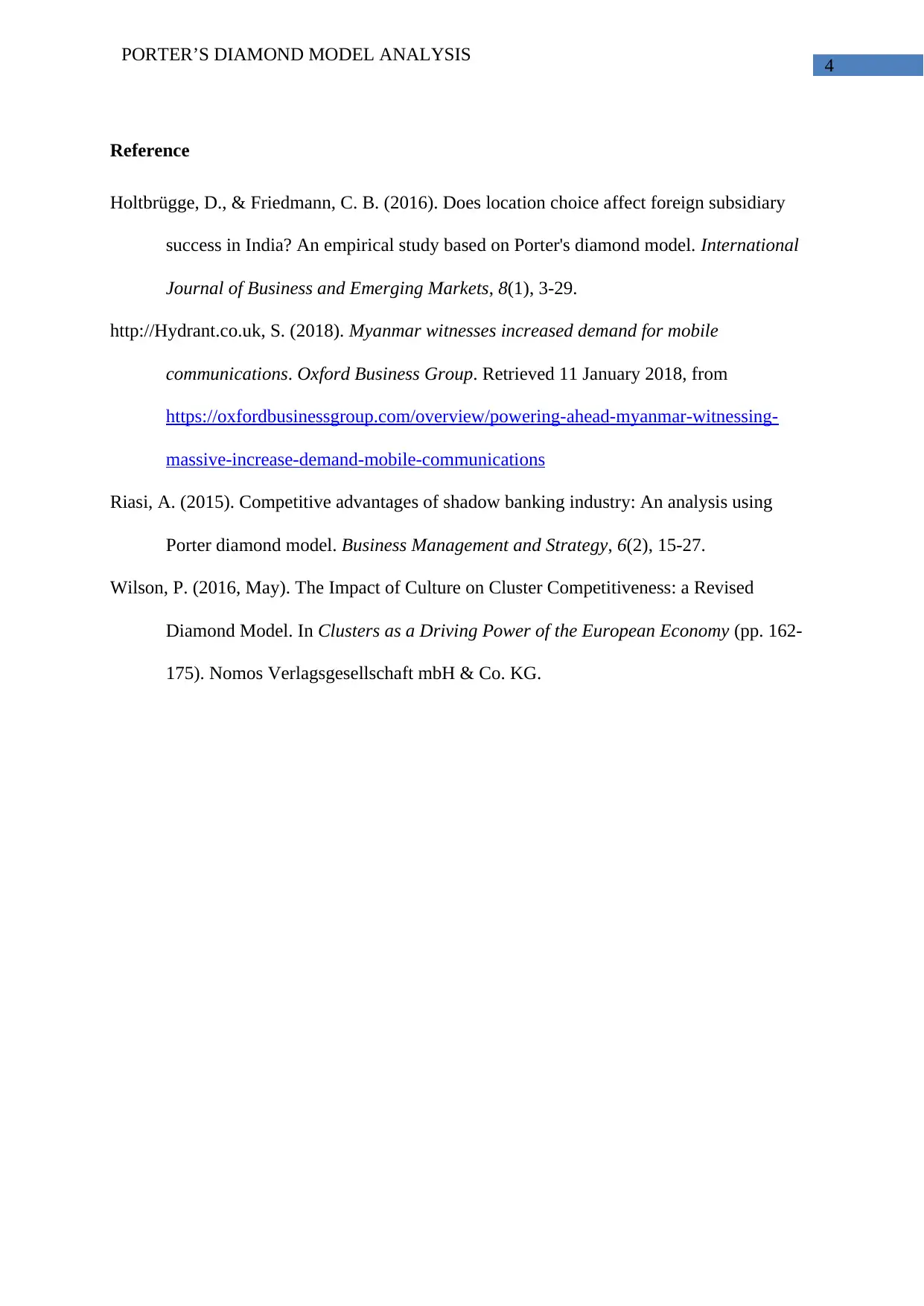
4
PORTER’S DIAMOND MODEL ANALYSIS
Reference
Holtbrügge, D., & Friedmann, C. B. (2016). Does location choice affect foreign subsidiary
success in India? An empirical study based on Porter's diamond model. International
Journal of Business and Emerging Markets, 8(1), 3-29.
http://Hydrant.co.uk, S. (2018). Myanmar witnesses increased demand for mobile
communications. Oxford Business Group. Retrieved 11 January 2018, from
https://oxfordbusinessgroup.com/overview/powering-ahead-myanmar-witnessing-
massive-increase-demand-mobile-communications
Riasi, A. (2015). Competitive advantages of shadow banking industry: An analysis using
Porter diamond model. Business Management and Strategy, 6(2), 15-27.
Wilson, P. (2016, May). The Impact of Culture on Cluster Competitiveness: a Revised
Diamond Model. In Clusters as a Driving Power of the European Economy (pp. 162-
175). Nomos Verlagsgesellschaft mbH & Co. KG.
PORTER’S DIAMOND MODEL ANALYSIS
Reference
Holtbrügge, D., & Friedmann, C. B. (2016). Does location choice affect foreign subsidiary
success in India? An empirical study based on Porter's diamond model. International
Journal of Business and Emerging Markets, 8(1), 3-29.
http://Hydrant.co.uk, S. (2018). Myanmar witnesses increased demand for mobile
communications. Oxford Business Group. Retrieved 11 January 2018, from
https://oxfordbusinessgroup.com/overview/powering-ahead-myanmar-witnessing-
massive-increase-demand-mobile-communications
Riasi, A. (2015). Competitive advantages of shadow banking industry: An analysis using
Porter diamond model. Business Management and Strategy, 6(2), 15-27.
Wilson, P. (2016, May). The Impact of Culture on Cluster Competitiveness: a Revised
Diamond Model. In Clusters as a Driving Power of the European Economy (pp. 162-
175). Nomos Verlagsgesellschaft mbH & Co. KG.
1 out of 5
Related Documents
Your All-in-One AI-Powered Toolkit for Academic Success.
+13062052269
info@desklib.com
Available 24*7 on WhatsApp / Email
![[object Object]](/_next/static/media/star-bottom.7253800d.svg)
Unlock your academic potential
Copyright © 2020–2025 A2Z Services. All Rights Reserved. Developed and managed by ZUCOL.





